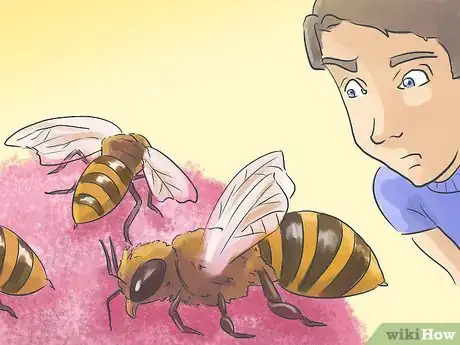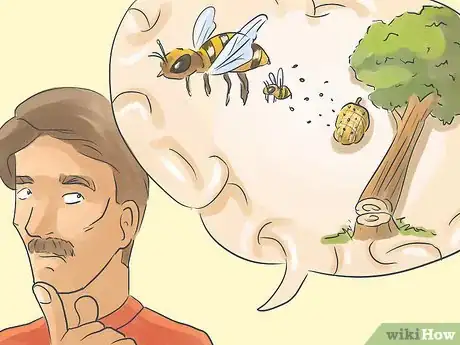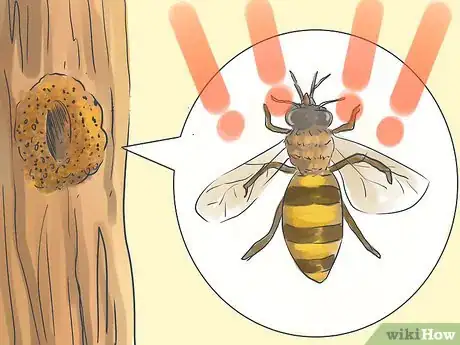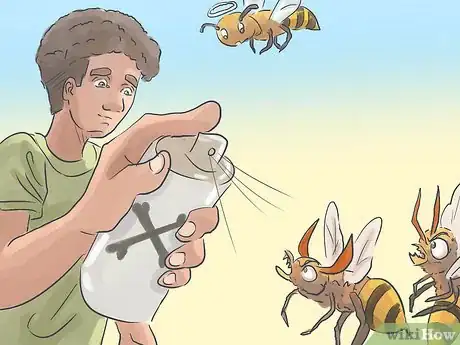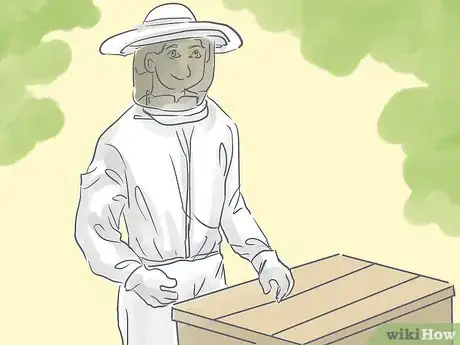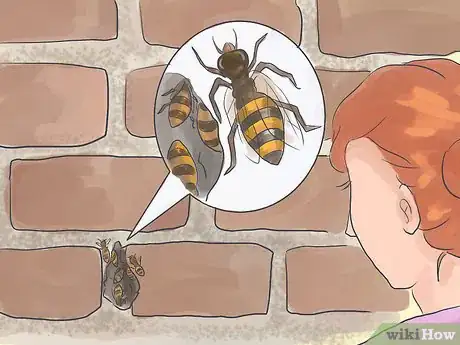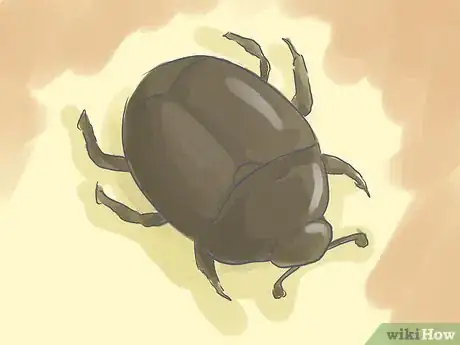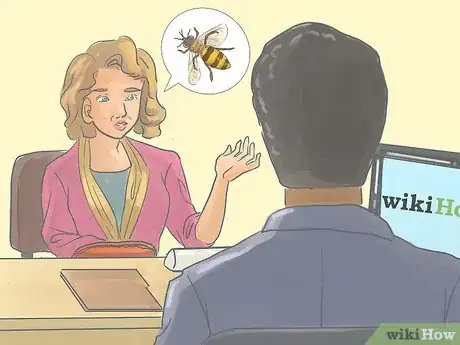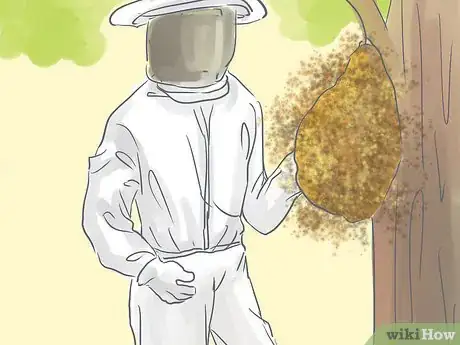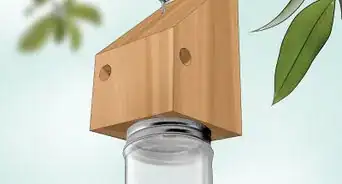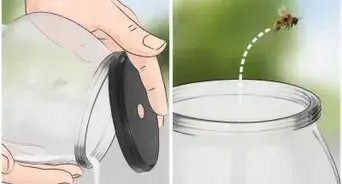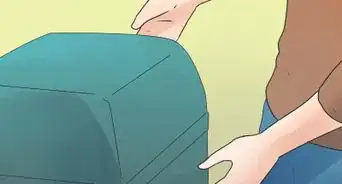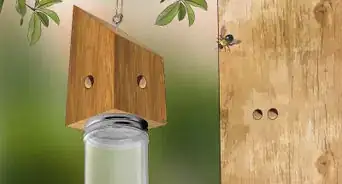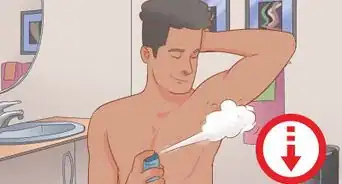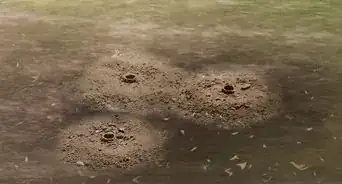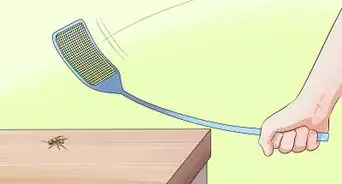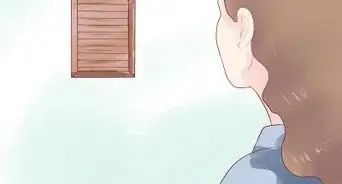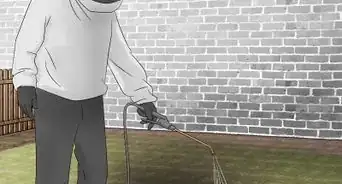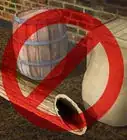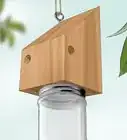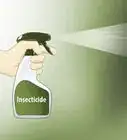X
This article was co-authored by Rod Yates, a trusted member of wikiHow's volunteer community. Rod Yates has been a professional Apiarist, specializing in bee removal, since 1992. He has also been a beekeeper since 1962. He has considerable experience and unique knowledge of bees, including infestations and removal.
This article has been viewed 36,125 times.
Learn more...
To solve any problem you first need to understand why it has happened. Bees often occupy places where they are not wanted, but they usually do this for consistent reasons. Knowing why bees behave how they do can help you get rid of them safely and sensibly
Steps
Method 1
Method 1 of 3:
Understanding Bees
-
1Simply observe the bees and think first. Careful observation is more likely to make sense of what is happening.
-
2Understand why bees swarm. When bees swarm, it's so their colony can spread out into new areas. This means they minimize the risk that a single disaster will wipe out their gene pool at one location, and they increase their chances of survival. Nature benefits because this also increases the number of bees for pollination. There are also other reasons, but this is the main one.Advertisement
-
3Beware of "feral bees." Bees not under human management, so called “feral bees”, cross breed and benefit from more defensive characteristics rather than increased productivity, therefore they tend to become more dangerous. Their poison is often more severe, and they more easily get angry. When they are difficult to handle, they can’t be checked for disease, and they can carry parasites that spread to healthy hives.
-
4Protect the "good" bees from the "bad." It's really important that we protect the managed bees that we rely on for pollination and honey from bees that can easily bring serious problems, such as parasites or disease. It often means that feral bees need to be removed by someone with proper knowledge to do this safely. If he can't safely check them for disease, its better that they are put down. He may need a licence to use chemicals safely, to do this job. The best chemicals for the job are virtually non toxic to humans, anyway.
-
5Don't put this job in the hands of an amateur, whether that's you or an untrained "professional"! Safe and careful intervention is essential for bee eradication that both prevents infestation and protects healthy bee populations. Further information follows.
Advertisement
Method 2
Method 2 of 3:
Dealing with Bees on Your Property
-
1Pay attention to what the bees are doing. Bees can show you why they do what they do, so you can work out how to change the circumstances that suit them. Changing their environment may discourage them from being there. Consider how they are controlling the air flow in the space they have chosen, maybe if this was increased, the space would be less appealing? Sealing up their entrance certainly won't.
-
2Consider why bees might be in your walls - and what to do about it. When bees locate themselves in a wall cavity, it's because they can control the updraft of the air in there. This helps them keep their brood at an even temperature, by speeding it up or slowing it down. In the right wall, they can sometimes really thrive!
- They will usually choose a brick veneer wall on the warm side of a building, because it heats up and cools down differently to how a much denser wall would. The bees calculate this thermal lag, and can take action to benefit their brood. If the sun is concealed by a cloud, they will know that the wall might cool down in a particular time "lag", and they can prepare to increase the temperature around their brood.
- You can make the cavity less appealing by opening the bottom and the top of the wall so more air rushes through and they can’t control the air flow. This is a non-chemical solution.
-
3Try to deal with bee problems quickly. If the bees have been established for some time, they will be reluctant to leave their brood. The pollen and honey they have stored to feed the brood, will attract cockroaches and in Australia, an insect called “Small Hive Beetle” (SHB, or sp. Athena Tumida). Quite often, the SHB will cause the honeycomb to break down into a vile, putrid slime, so its wise to eliminate the bees before SHB gets established.
-
4Call in a professional to eradicate infestations. This should be done by blowing a professional Permethrin-based powder into the cavity so well that it dusts all surfaces. This chemical is low toxicity and safe for humans. The bees will then find the cavity repellent, and not nest there.
- The job should be done by someone with equipment to blow the powder in at high pressure so it circulates thoroughly. This can be done from a safe distance with a long pipe thin enough to fit into the hole that the bees use as an entrance.
- Eventually, about three months later when the powder has lost some of its power, a small moth (sp.galleria Mellonella, or Wax Moth) will get in and eat up the remaining wax, leaving the cavity empty as it used to be, without significantly damaging the building. Wax moths are everywhere. The powder will also kill the cockroaches.
-
5Know where to go for help. As mentioned, safe and sensible bee eradication requires professional help. You might find such a person by consulting your local Council, Wildlife Rescue Service or Department of Agriculture.
Advertisement
Method 3
Method 3 of 3:
Avoiding the Pitfalls
-
1Do not use liquids, aerosol sprays, or other chemical types which may create new problems. Aerosols will kill some bees, but cause the rest to be confused and spread out in the wall so the problem becomes more extensive.
-
2Do not block up the holes that the bees used for access. If new bees come around, they need to be able to determine that the cavity is repellent, so they give up and go away. If they can't get in to where the powder is, they become more determined and will enter the wall further away, and walk along leaving the scent marker as they go. A new colony might set up just outside the range of the powder.
- Also, the wall still needs to be able to ventilate itself so it doesn’t become musty. So many houses are damaged with materials such as foaming resin and silicone that have been used to block bees. This almost always encourages bees to try again.
-
3Don't worry about "saving the bees." Many people blindly assert that feral bees should be “saved." This is not a very sensible idea. After all, bees only live about 8 weeks,and all their characteristics are fixed at birth. It takes that long for the colony to be rehabilitated with a new queen to produce more useful brood because the old bees have to die off first. It's far better to accept that to control the spread of disease, some bees have to be eliminated to protect the healthy colonies under good management.
- One of these well managed colonies can easily be divided and made productive in only a week or so to make up for the loss of a bunch of ferals. It’s the same as having problems with cattle that have serious illness; you just don’t go and put them in with the healthy cows.
-
4Don't take risks or skimp on bee removal. Our lives depend on food crops pollinated by healthy bees. It is much better to call on an experienced person who knows what he or she is doing with bees. Accept that if there is expertise and or chemicals involved, they will need to be paid fairly, as you would pay any professional.
Advertisement
Expert Q&A
Did you know you can get expert answers for this article?
Unlock expert answers by supporting wikiHow
-
QuestionHow do I get rid of carpenter bees?
 David WilliamsDavid Williams is a Professional Beekeeper and Bee Removal Specialist with over 28 years of beekeeping experience. He is the Owner of Bzz Bee Removal, a bee removal company based in the San Francisco Bay Area. Bzz Bee Removal locates, captures, and transports bees to local beekeepers to prevent colony collapse disorder.
David WilliamsDavid Williams is a Professional Beekeeper and Bee Removal Specialist with over 28 years of beekeeping experience. He is the Owner of Bzz Bee Removal, a bee removal company based in the San Francisco Bay Area. Bzz Bee Removal locates, captures, and transports bees to local beekeepers to prevent colony collapse disorder.
Beekeeper & Bee Removal Specialist
-
QuestionHow can I bee-proof my outdoor patio?
 David WilliamsDavid Williams is a Professional Beekeeper and Bee Removal Specialist with over 28 years of beekeeping experience. He is the Owner of Bzz Bee Removal, a bee removal company based in the San Francisco Bay Area. Bzz Bee Removal locates, captures, and transports bees to local beekeepers to prevent colony collapse disorder.
David WilliamsDavid Williams is a Professional Beekeeper and Bee Removal Specialist with over 28 years of beekeeping experience. He is the Owner of Bzz Bee Removal, a bee removal company based in the San Francisco Bay Area. Bzz Bee Removal locates, captures, and transports bees to local beekeepers to prevent colony collapse disorder.
Beekeeper & Bee Removal Specialist
Advertisement
Warnings
- Don't over protect yourself. If working with bees, it is more dangerous to be clumsy due to heavy gloves etc, Best to remain quiet, cool and calm.⧼thumbs_response⧽
Advertisement
About This Article
Advertisement
